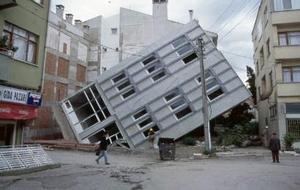EarthquakesAre large earthquakes linked across the globe?
The past decade has been plagued with what seems to be a cluster of large earthquakes, with massive quakes striking Sumatra, Chile, Haiti, and Japan since 2004; some researchers have suggested that this cluster has occurred because the earthquakes may be “communicating” across large distances, possibly triggering each other; a new analysis, however, that the cluster could just as well be the result of random chance

Building toppled by massive Turkish quake // Source: portaloko.hr
The past decade has been plagued with what seems to be a cluster of large earthquakes, with massive quakes striking Sumatra, Chile, Haiti, and Japan since 2004. Some researchers have suggested that this cluster has occurred because the earthquakes may be “communicating” across large distances, possibly triggering each other. A new analysis by Tom Parsons and Eric Geist concludes, however, that the cluster could just as well be the result of random chance.
A Seismological Society of America release reports that each of the devastating quakes in the 2000s drew huge media coverage and required extensive rebuilding and economic restoration. The intense interest in the earthquakes has led some to wonder if we are living in the middle of an “age of great quakes,” similar to a global cluster of quakes in the 1960s. It is important to know whether these clusters occur because big earthquakes trigger others across the world, Parsons and Geist say, in order to predict whether more severely destructive quakes might be on the way.
To determine if the quake clusters in the 1960s and 2000s could be attributed to random chance, the researchers looked at the timing between the world’s largest earthquakes — magnitude 8.3 and above—at one-year intervals during the past 100 years. They compared simulated lists of large quakes and the list of real quakes during this time with the between-quake intervals expected from a random process. The intervals between the real-life large quakes are similar to what would be expected from a random process, they found. In other words, the global hazard of large earthquakes is constant in time. Except in the case of local aftershocks, the probability of a new large quake occurring isn’t related to past global quakes.
This could be disappointing news for researchers who thought global communication between quakes might offer a way to predict the most severe seismic activity. There also may be some good news, however, after a decade of destruction. If global great earthquakes are occurring at random, the authors say, then a specific number of quakes that cluster together within a short time is unlikely to be repeated in a similar way over a 100-year span.
The paper, “Were Global M8.3 Earthquake Time Intervals Random between 1900 and 2011?” by Tom Parsons and Eric Geist of the U.S. Geological Survey, will appear in the August issue of the Bulletin of the Seismological Society of America.
